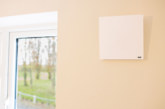A five-year partnership between industry and academia has resulted in a ground-breaking diagnostic tool to combat the risks posed by condensation, damp and mould.
The Building Moisture Index (BMI) assesses the moisture balance and imbalance in homes and buildings and provides an independent report with recommendations to rectify any issues. The BMI has been developed by the Property Care Association (PCA) and partners in academia — and could help thousands across the UK.
Condensation, damp and mould are common problems — particularly in autumn and winter — caused by excess moisture in a property which can impact on air quality and health. Exclusively available to members of the PCA, the BMI tool allows surveyors to better understand, quantify and rectify imbalances which can cause condensation and mould issues in buildings.
In 2015, the PCA and University College London Institute for Environmental Design and Engineering (UCL IEDE) formed a Knowledge Transfer Partnership (KTP) to examine ways to tackle excessive atmospheric moisture. Since then, intense research and detailed studies at more than 100 UK properties, have led to a market-ready tool which has been hailed a ‘game-changer’ for the industry.
Dr Paula Lopez-Arce (pictured above), who has more than 20 years’ experience gained in the built environment, was the KTP Associate for the research project and is now working as PCA research scientist and commented: “We believe this has been one of the largest, most practical and challenging environmental monitoring projects of its type undertaken in UK homes.
“Measurement devices including environmental sensors have been placed into different types of dwellings to measure conditions, such as temperature and relative humidity as part of the activity.
“The data collected has helped us to build a picture of the issues surrounding excess atmospheric moisture across a mixed portfolio including flats, bungalows, terraced and detached houses in different regions, to cover a representative mix of property types.
“It’s been an exciting project with the end solution having a transformational impact on the condition of homes worldwide, ensuring better indoor air quality and healthier environments”
Steve Hodgson, Chief Executive of the PCA, said: “This ground-breaking mixture of academic and industrial research has become tangible, practical and real with the launch of the BMI diagnostic tool. It will have a significant impact on the quality of air indoors for hundreds of thousands of people across the UK and internationally.
“We have discovered that we can analyse conditions within a building in order to understand precisely why it is out of balance in terms of its moisture levels, and then prescribe the correct solutions to address the issue. We also have the potential to predict conditions, so properties can be protected proactively.”
Condensation, dampness and mould in the home can increase the likelihood of respiratory problems, respiratory infections, allergies or asthma.
In recent years, the PCA has reported a surge in the levels of excess atmospheric moisture in properties across the UK, with many of the trade body’s 400 members encountering higher levels of humidity in homes than ever before. This year it is concerned that the impact of COVID-19 could lead to even higher levels of the condensation.
Steve added: “Colder temperatures, and more time spent inside during the short days will inevitably lead to humid environments, mould and condensation. As a result, we believe that the winter of 2020/21 could be worst condensation season ever.
“Left unchecked, resulting problems from excess moisture can include poor air quality, condensation, dampness and mould. These are issues which can affect people’s quality of life and it’s important that we act to resolve this situation.
“There’s a real demand for a diagnostic technique and the PCA’s membership has supported its development both financially, and by enabling the research team to tap into its expertise.”
A video produced by the PCA, which is available to view here, offers a comprehensive insight into the issue of air quality in homes.









